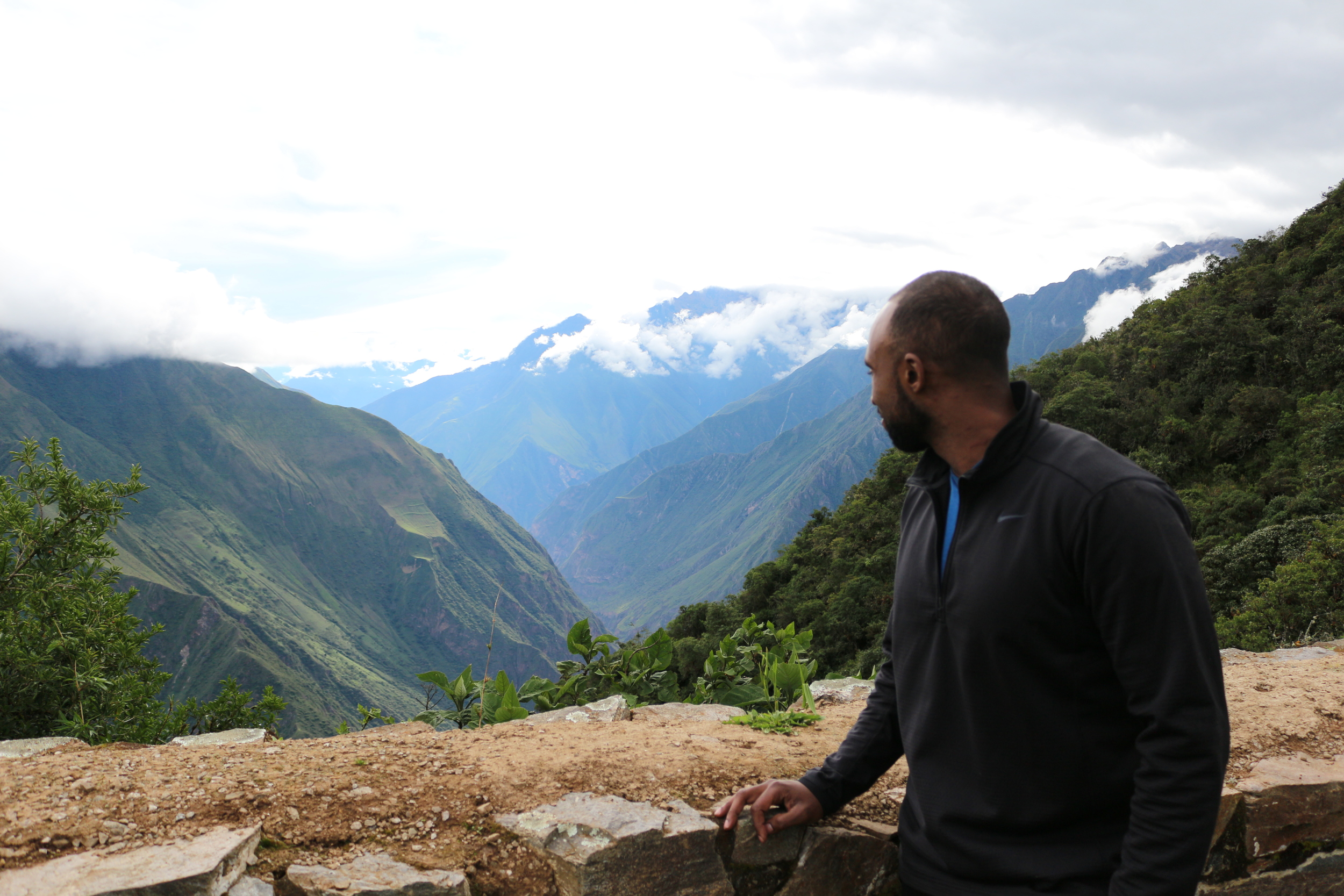A trek above the clouds: Choquequirao
After the jokes have been told, anecdotes have been recounted, and the short list of songs that you can sing from memory harmonized, that is when the true hike begins. It's at this point when the rhythm of the trek becomes consistent - heavy breathing accompanied by the comforting click and reverberation of my hollowed-out cornstalk walking stick and the staccato accents of zippers and bug spray squirts. These are the true soundtrack of a long hike. We had moved past sharing our personal details with the guide - cuantos hermanos? Uno. en que trabajas? Ingeniero. Como te gusta Peru? Er... me gusta pisco.
With my broken Spanish, it didn't take long to go through the pleasantries, but Sofia's knowledge and experiences living in Peru made the conversations during the hike to Choquequirao flow for the first 2 days before we got to where the real fun began.
Choquequirao is a lesser-known historical Inca site about 20 miles southeast of Machu Picchu as the condor flies. And if you're doing the extended trek from one to the other, I'm sure you will envy the scrawniest of condors, as the hike to Choque is daunting. To give an idea, the roughly 17 mile trek starts out modestly, climbing from 9000 ft in elevation to 9750 ft over the first 7 miles. Then the fun starts on the second day.
The second day has you descend close to 5000 ft over 4.5 miles in a dizzying series of switchbacks. My only thought while completing this was "don't think about the way back up." Our guide, Alex, did a good job of distracting us, telling us jokes like - "a horse walks into a bar. The bartender asks, why the long face?" Jajajaja. Or this classic genie joke as told by Alex - "I have a wish to get with the most beautiful woman in the world, one man tells a genie. Instantly, the genie does his thing and Mother Theresa is by the man's side. No, no, no - you don't get it, continues the joke. Beautiful! She beautiful like you said, the genie explains. No, let me try again - I want to have a... er... dick that touches the ground." Alex gives a wry smile. "And so genie responds by chopping off the man's shins." Jajajajaja. "It's good, right?" Alex pleads for some confirmation.
And so it was that this was our guide, who would lead us through the names of towns that sounded like tasty dishes to me - the descent from Capuliyoc through Chikiska and Cocamasana to Playa Rosalinda, close to the Rio Apumirac valley. What could go wrong?
We descended dutifully on the second day, getting to Chikiska around noon, watching all of the travelers collapse on a mosquito-filled bench in the middle of the camp, looking like the opposite of an REI ad. Shoes were untied, intentionally or not, water pooled wherever the bottles ended up after a last sip, eyes were glazed behind sunglasses neither functional or fashionable. It was the bench of exhaustion - or the bench of dread. "Really? We have to go back that way?" or "Really? The ruins were amazing, now we just want an elevator." Sofia and I thought we were tired, but in good spirits. Nothing an Inca Kola and a few mana sugary corn snacks couldn't take care of.
We camped (against the advice of reviews we had read) next to the mosquito-breeding river, putting up a not-so-eipc fight against the mosquitoes to battle another day. Questionably refreshed, and ready to see the ruins, it was the third day that tested us. We started out at the base of the river valley, hiked up 5000 ft of elevation in 5 miles to arrive at the beautiful, water-filled, orange-filled city of Marampata. Or perhaps it was a small collection of houses with a few snacks and drinks to sell. Never trust what you eat on a hike, because if you attempt to duplicate how delicious a meal of luke-warm spaghetti and hot sauce is in your daily life, you're sure to be disappointed. But Marampata was beautiful.
The whole hike was beautiful, to be honest. Our choice to go at the end of the rainy season was the perfect timing of the weather not being too cool and the scenery being Shire green. As Sofia exclaimed over and over, it reminded her of the hills of New Zealand - blue sky, impossibly verdant carpeted hillsides, and crayola-bright wildflowers everywhere you looked. To me, it was reminiscent of a painting on all sides - anywhere you focused, it could be a still life snapshot. Do I want to paint birds and shadows, clouds and dancing sunbeams, flowers and running water? No canvas would be any less inspiring.
And that was before the city of Choquequirao itself. Better writers than I have described the architecture and significance of the ruins - these were the articles that led me to the trek in the first place. But you don't have to be a writer to appreciate what Alex told us of the meticulous stonework of the Incas - 8 degree incline or decline for all walls to better deal with earthquakes, stones that sit flush against one another for places of royalty. There were areas of religious importance - to worship the sun and moon by men and women respectively, and of strategic importance - terrace after terrace for battle training, and agriculture, as well as a viewpoint to observe and plan against threats from all sides. When we arrived at the site, unlike Macchu Pichu, on Easter Sunday, we were the only ones there. We could take our time to observe what the ruins had to offer without distraction or salesmen. While the hike and surrounding towns could use some improved infrastructure, I hope it it's a long time before the planned cable car from Santa Rosa to Marampata transforms Choque into another bucket list item visited by millions each year like Machu Picchu.
Choquequirao, like all important Incan cities, is laid out in alignment with the movements of the sun and the stars. One building on the central plaza has nooks in which the mummies of important citizens were placed, and it is onto these nooks that the first rays of dawn fall each day.
The city’s central temple is a small rectangle on the other side of the plaza with evenly spaced depressions for altars and stone hooks where the priests hung their raiment. The most striking feature about the temple is how tiny it is; like those at Machu Picchu, it could fit perhaps 20 worshipers and had very little of the architectural grandeur of a mosque, a church or a synagogue. But then, an attempt at human grandeur here, in the shadow of the jagged jungle peak Corihuayrachina and facing arid, domelike mountains so gargantuan they make clouds look small, would seem redundant at best.
Although Choquequirao is more spread out than Machu Picchu, and therefore less photogenic, the promontory on which it lies reaches its zenith with a ceremonial hill behind the plaza, a smaller version of the rugged mountain seen in every photograph of Machu Picchu. The hike up takes just a few minutes but affords a 360-degree view of the ruins and the surrounding landscape. The curious feature of the hill is that it was scalped, flattened and denuded of vegetation by the Incas so their priests could perform rituals there. (NYT 2007)
But unfortunately or trek did not end with teleporting from the ruins into a bar filled with Pisco drinks and Marinera dancing. We still had to return to our river valley campsite, 5000 ft down the mountain, and thanks to the careful planning of Alex, we would be completing this part of the hike in darkness. And it's here where the soundtrack of shuffling feet and hiking sticks received a welcomed addition. As we left the gates of Marampata, another guide joined us, Sombra, I named him after the spanish word for shadow, a black, collie-looking dog with white paws perfect for following in the waning sunlight led us down the mountain. As Alex said, you never question when you're given an animal to guide you. Long after our questionable jokes and more questionable Disney song lyrics had been shared, it was Sombra who proved to be the best guide - patient but watchful, silent but powerful, Sombra led us down the mountain, inspiring us to continue while providing the safety needed to be brave.
We had experienced Choque - a little bit spiritual, a little bit physical, a little bit ancestral, it's a place where what you interpret is above the clouds - nature or otherwise - can be met in solitude.



























